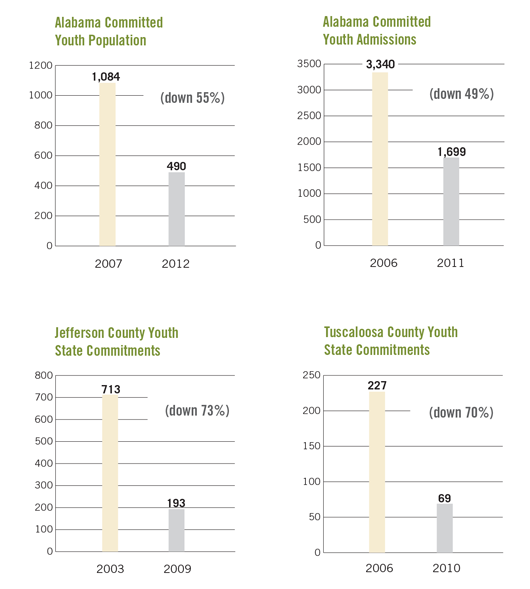Alabama Practices Reduce Detention Populations and State Commitments
Several Alabama JDAI sites have reduced their detention populations and kept low-level youth out of secure care. They have lessened the burden on state youth corrections and helped sustain reductions in the institutionalized populations.
In 2008, Alabama passed legislation banning the incarceration of status offenders. The legislation was the culmination of a long-term collaborative effort by stakeholders throughout the system—judiciary, executive, legislative, state and local government, advocates, and public officials—to improve outcomes for youth and to make the juvenile justice system more accountable.
As admissions to state youth corrections declined, local officials were concurrently developing fundamental JDAI strategies to reduce the flow of youth into detention and identify home- and community-based options for low-level youth and misdemeanants.
During this time period, the state’s committed population shrank by 55%, going from 1,084 in May 2007 to 490 in February 2012. Admissions dropped by 49%, going from 3,340 in 2006 to 1,699 in 2011.

The change in admissions was driven largely by sharp reductions in the number of youth admitted to state custody for status offenses, violations of probation, and minor public order offenses, according to an analysis by the Juvenile Justice Strategy Group at the Annie E. Casey Foundation. Of the 1,438 fewer admissions between 2006 and 2010, 77% (1,103) were for low-level referrals.
As Alabama downsized its state correctional system, four large metropolitan areas became JDAI sites and began to implement fundamental detention reform strategies to reduce the use of detention. Several sites saw results immediately as they reduced admissions to state custody and to their detention center.
The Jefferson County (Birmingham) JDAI site reduced its state commitments by 73%, going from 713 in 2003 to 193 in 2009. Admissions to the Jefferson County detention center were also down, going from 1,650 in 2006 to 948 in 2010.
Jefferson County officials worked to strengthen local decision-making procedures affecting the use of secure detention. They implemented new intake policies and risk instruments focused on handling status offenders informally, diverting youth, whenever possible, from court involvement. This resulted in smaller probation caseloads and fewer “Children in Need of Supervision” referrals, according to the analysis.
An innovative JDAI-related policy is reducing school-based referrals to juvenile court for minor infractions. Jefferson County educators are assuming greater responsibility to respond to school-based conflicts and allowing students two warnings, with appropriate interventions, before referring to juvenile court.
The Tuscaloosa County JDAI site reduced its commitments to state custody by 70% between 2006 and 2010, going from 227 to 69.
The Montgomery County JDAI site reduced its state commitments by 23% between 2006 and 2010, and at the same time reduced admissions to its detention center by 37% between 2006 and 2010.
In most of the jurisdictions utilizing fundamental JDAI core strategies—including risk assessment, case planning, collaboration, reallocation of funds, and community-based alternatives—the local detention populations are considerably lower today than they were when the state deinstitutionalization efforts began.
The state’s committed population has not returned to anywhere near previous record-breaking levels.
However, after an impressive early effort that resulted in 47% fewer referrals to state custody across the four JDAI sites, more recent data indicate that reductions in commitments and detention have held steady.
For more information, contact Karen Baynes-Dunning.





